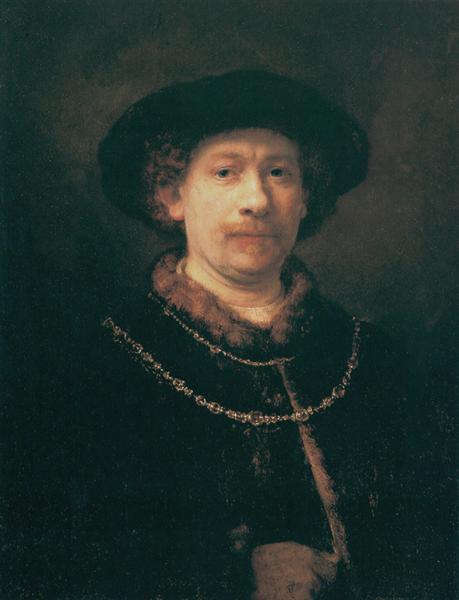Description
Rembrandt’s Self-Portrait, painted in 1643, stands as an exceptional testament to the artist’s mastery and ability to capture the complexity of the human being. In this painting, which is in the collection of the National Museum in Warsaw, the viewer is confronted with a frontal image of Rembrandt himself, revealing not only his physical appearance, but also a deep sense of introspection and vulnerability.
The composition of the work is notable for its simplicity and use of space. Rembrandt chooses a dark background, which creates a strong contrast with the lighter tones he uses for his face. This choice highlights his figure, allowing the viewer's eyes to focus on the artist's detailed and vivid portrait. His direct gaze, which seems to challenge the viewer and at the same time invite them to contemplate their thoughts, is one of the most captivating aspects of the work. The emotional connection he establishes with the observer is a hallmark of Rembrandt's style, being able to convey a vast range of emotions through a simple glance.
The use of colour in this self-portrait is another element worthy of analysis. The predominant earthy tones in the palette, such as browns and golds, give the work a warmth that contrasts with the coldness of the background. The light, which seems to come from an upper left corner, focuses on the painter's face and hands, creating a play of light and shadow that suggests volume and depth. This chiaroscuro effect, which Rembrandt himself perfected throughout his career, is emblematic of the Baroque, the style in which this work is inserted. It is not just a lighting technique, but a visual language that allows the artist to explore the duality of human existence: beauty and fragility, light and darkness.
Within the context of its time, this self-portrait is also interpreted as an act of self-affirmation. By 1643, Rembrandt was beginning to gain recognition in the art world, and through his work he was not only establishing his reputation but also leaving a legacy that would transcend time. This portrait, in particular, can be considered a manifestation of the growing interest in the self and subjectivity that characterized the art of his time. It is perhaps interesting to note that he made multiple self-portraits throughout his career, but this one, in particular, captures a moment of self-awareness and personal reflection.
The authenticity of his depiction is another key point. Rembrandt, unlike many of his contemporaries who opted for idealisation in their portraits, presents a sincere image. The wrinkles and marks visible on his face convey both experience and wisdom, and at the same time a sense of the inevitable passage of time. This honesty and vulnerability are fundamental to understanding his work and his connection with the viewer, allowing his art to resonate in different contexts and times.
In conclusion, the 1643 “Self-Portrait” is more than just an image of the artist; it is a profound exploration of identity, light and shadow in the human experience. Rembrandt, through his technical mastery and ability to communicate complex emotions, has created a work that invites reflection on the nature of the human being and the experience of living. In this self-portrait, each brushstroke not only reveals his skill as a painter, but also his deep understanding of the human condition, cementing his legacy as one of the greatest geniuses of Western art.
KUADROS ©, a famous painting on your wall.
Hand-made oil painting reproductions, with the quality of professional artists and the distinctive seal of KUADROS ©.
Painting reproduction service with satisfaction guarantee. If you are not completely satisfied with the replica of your painting, we will refund 100% of your money.

